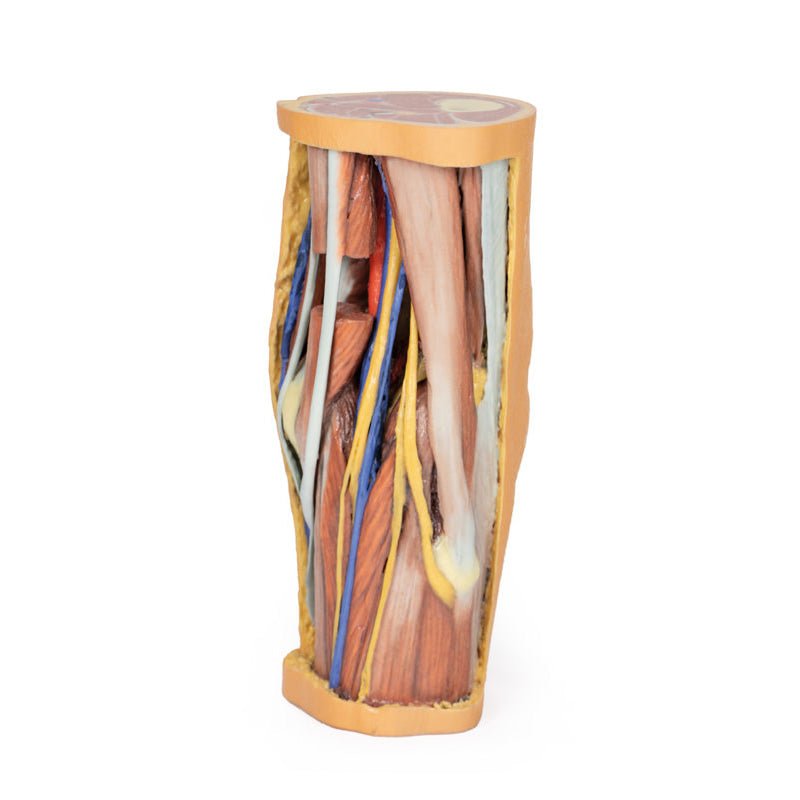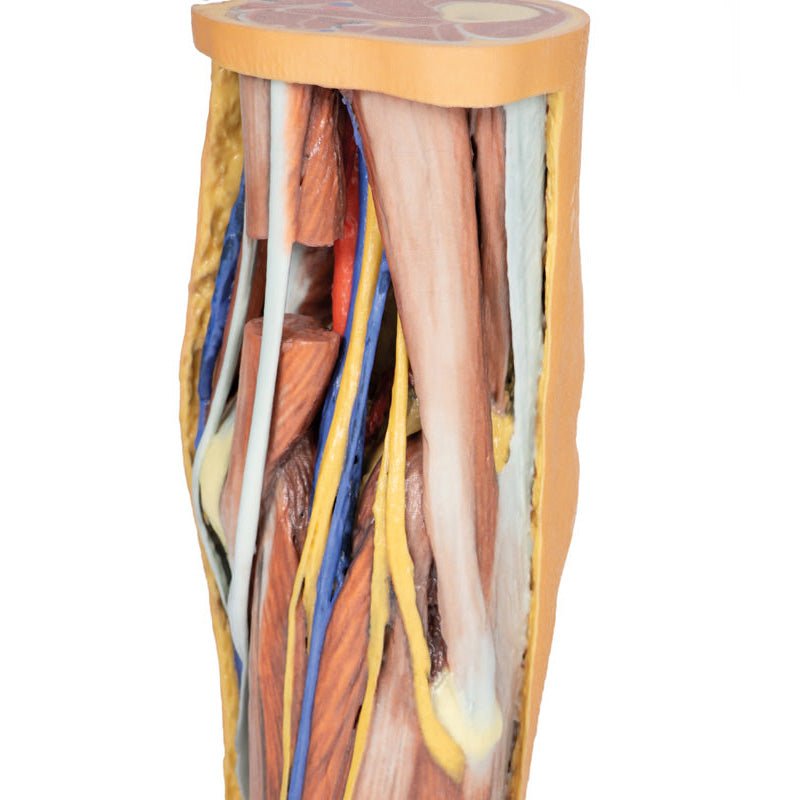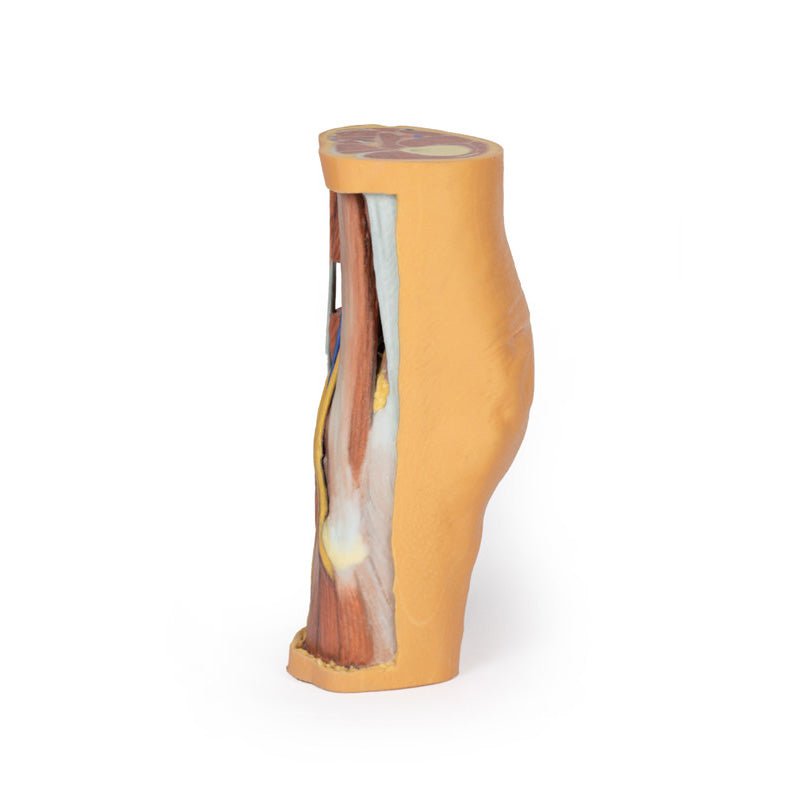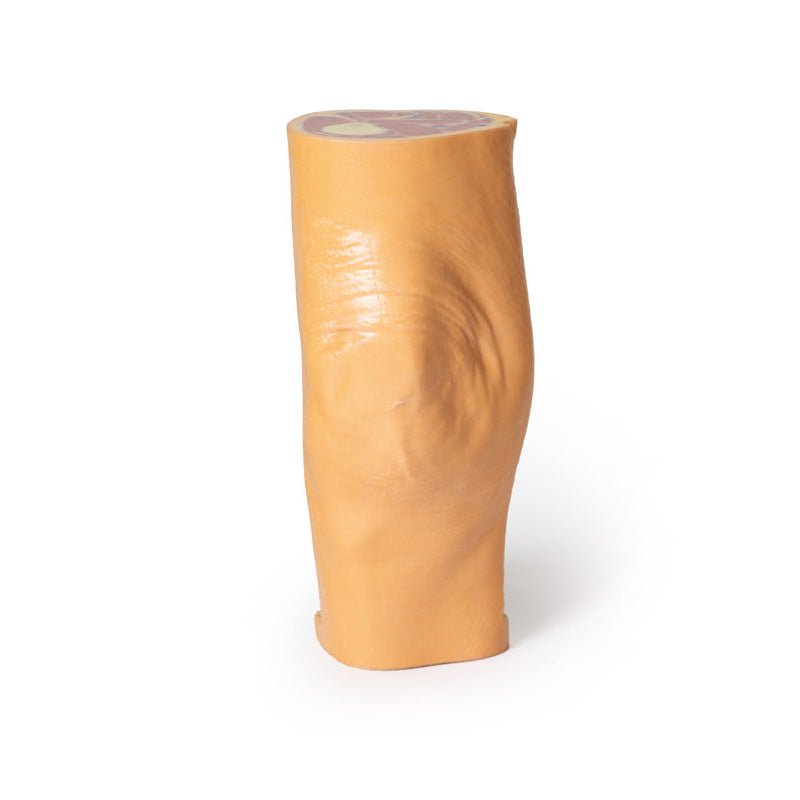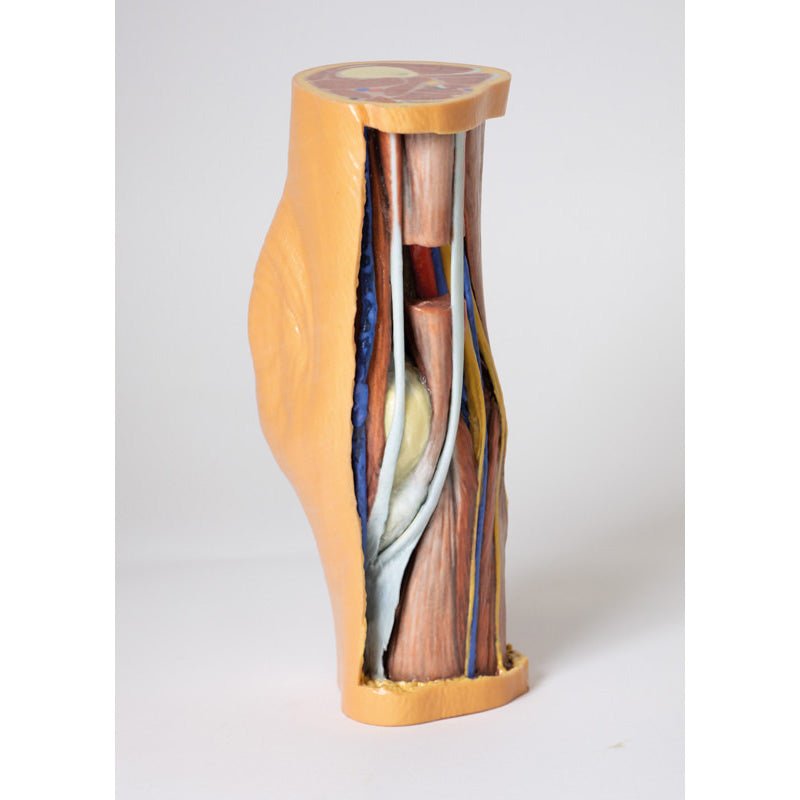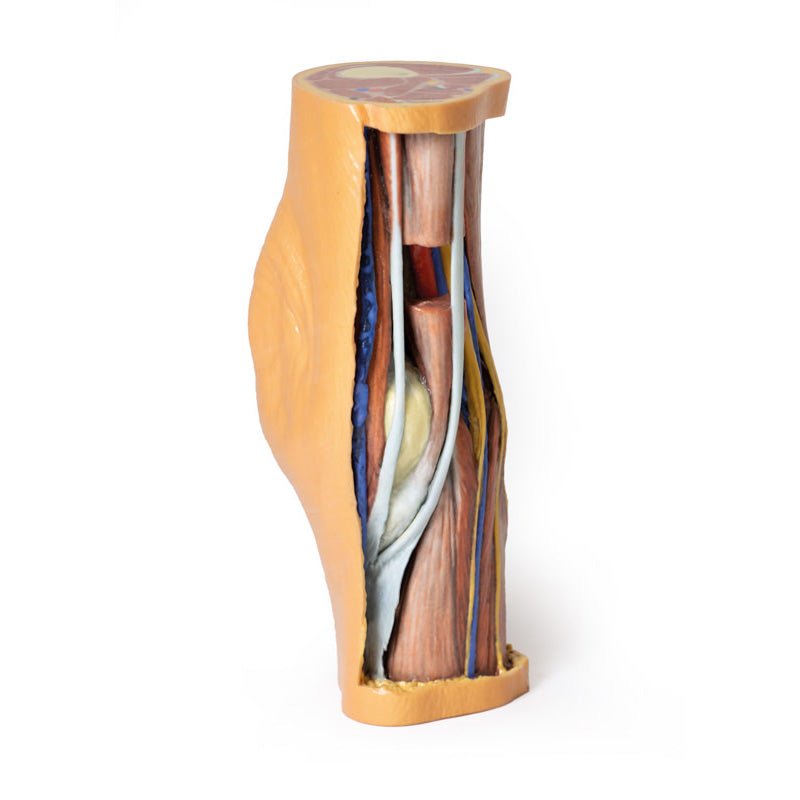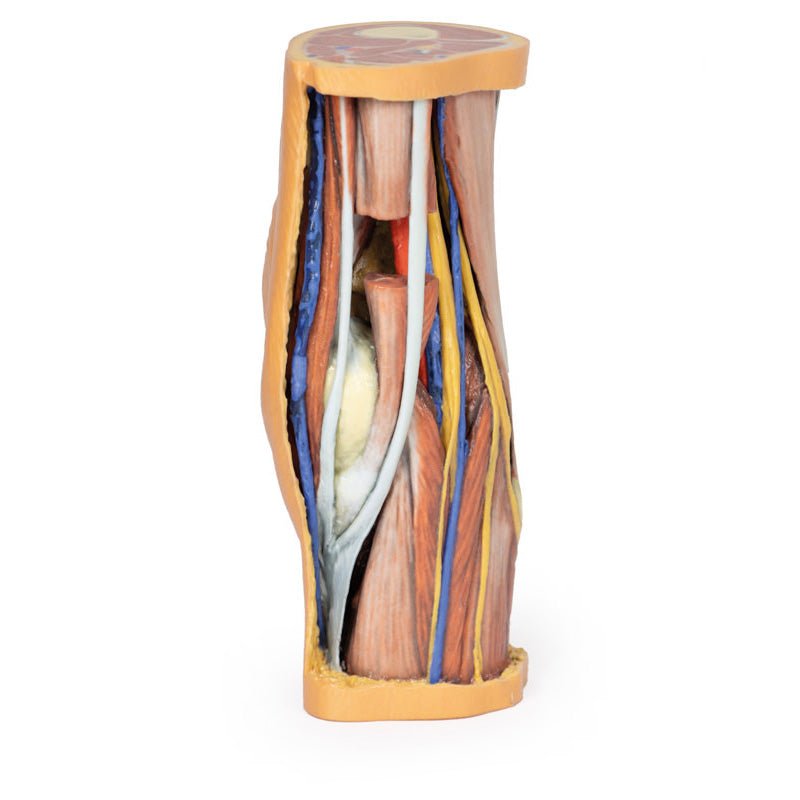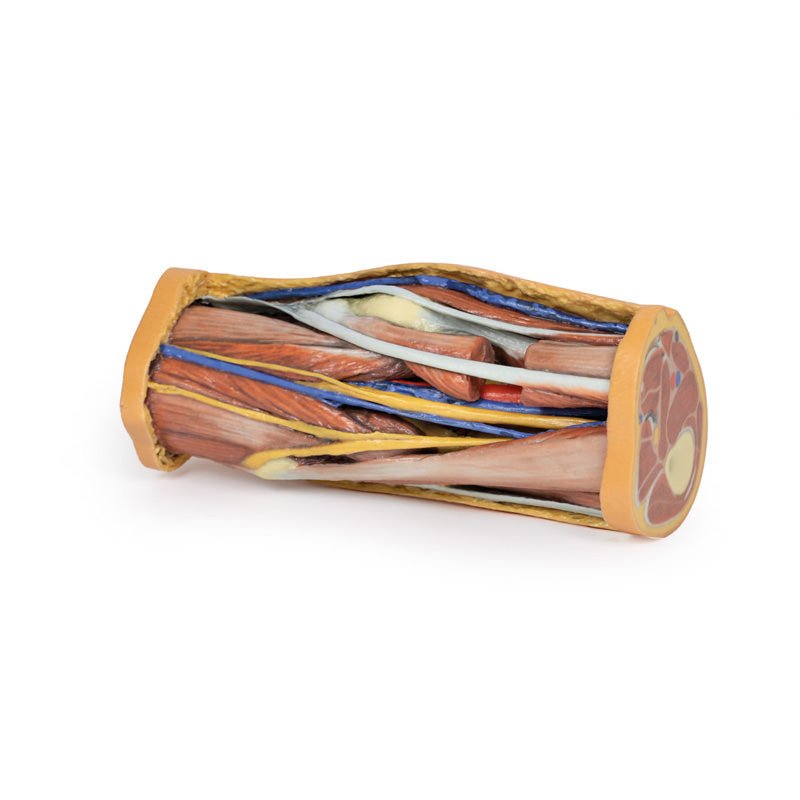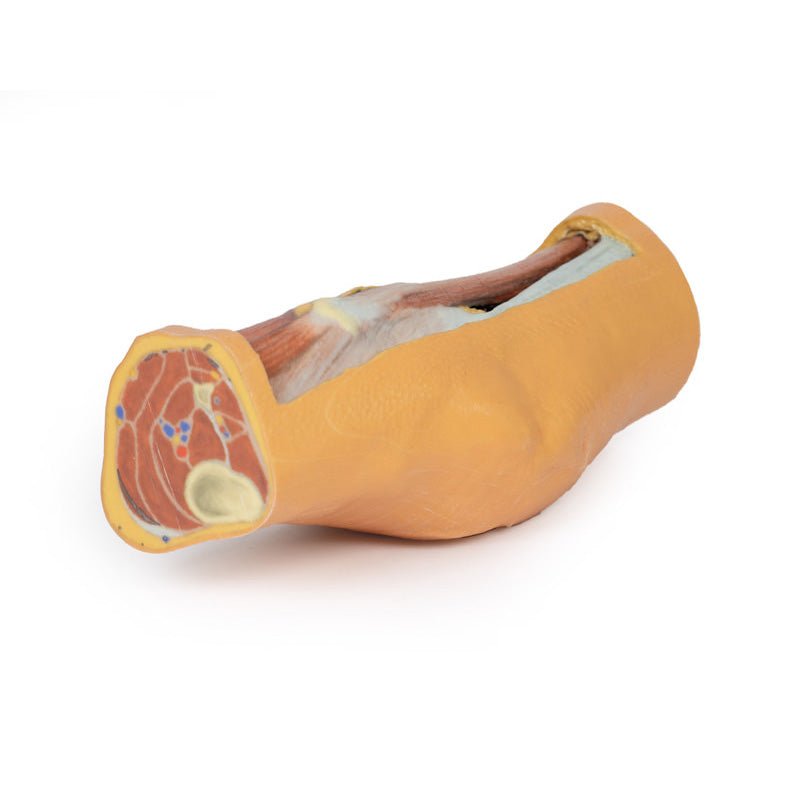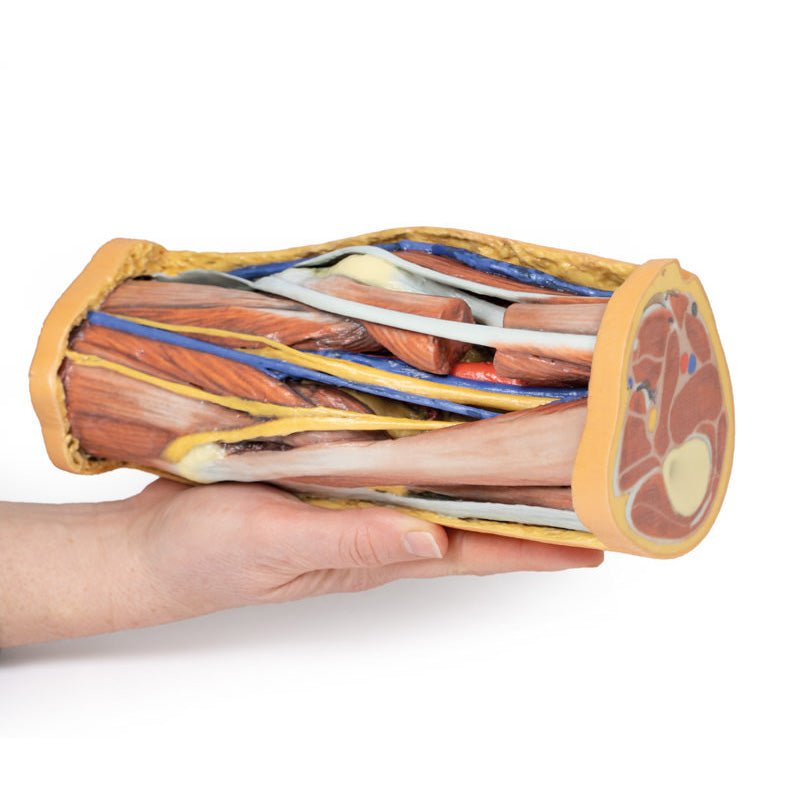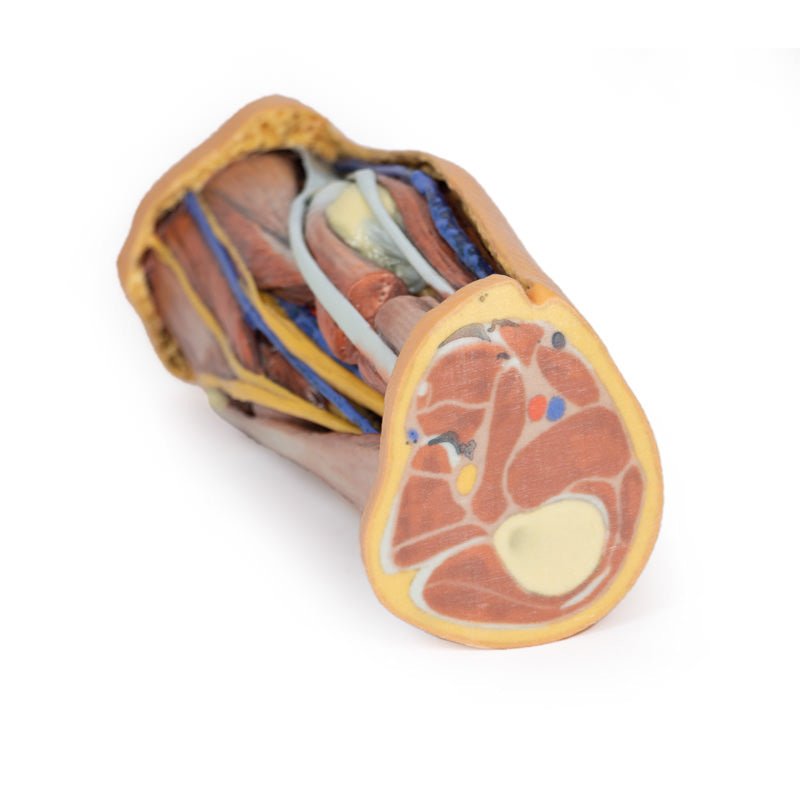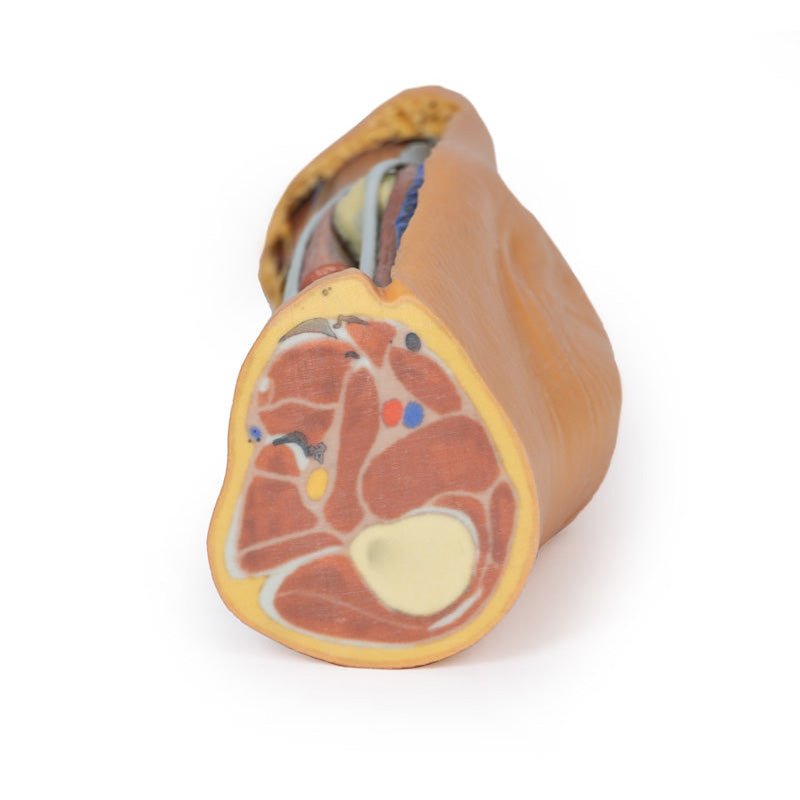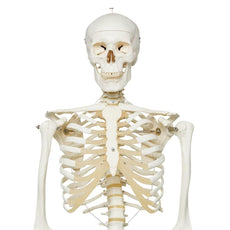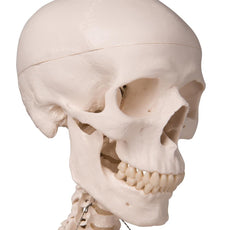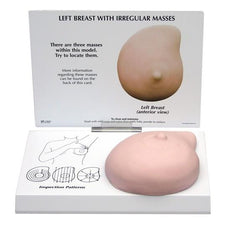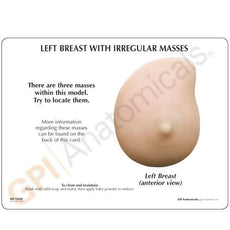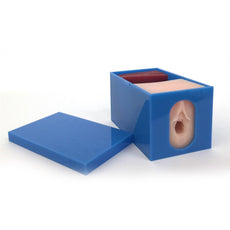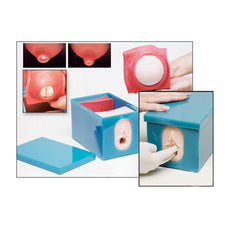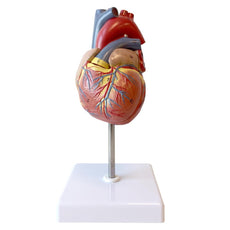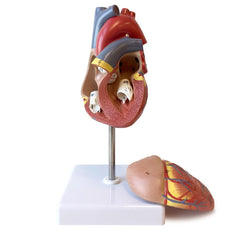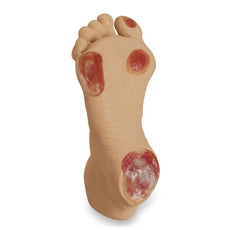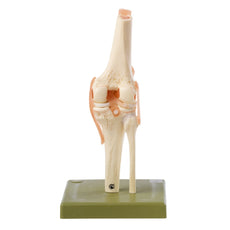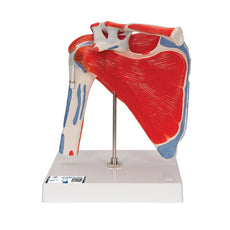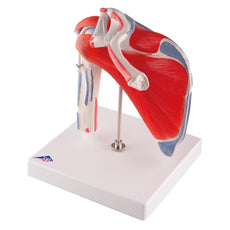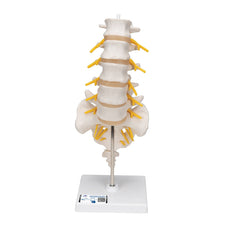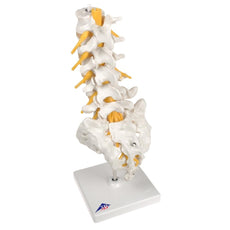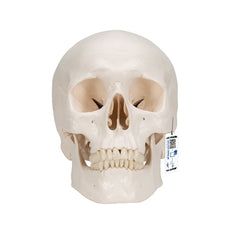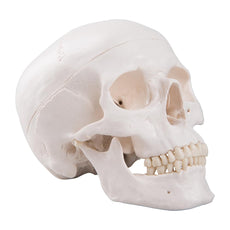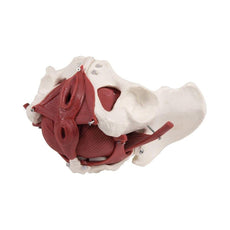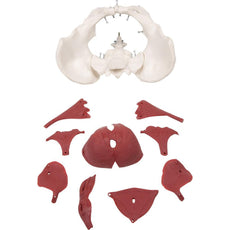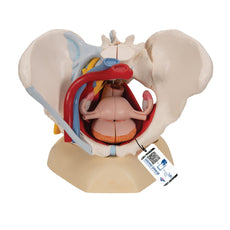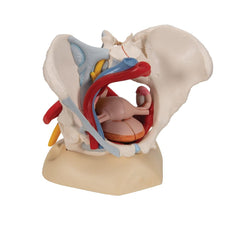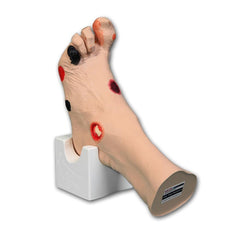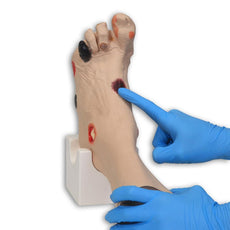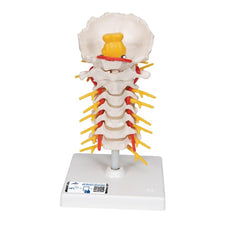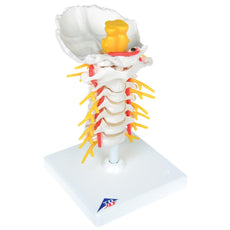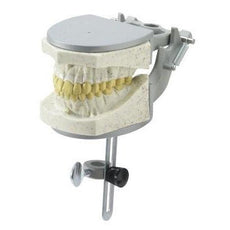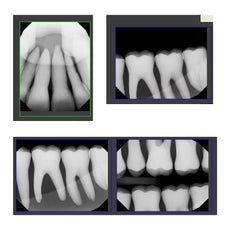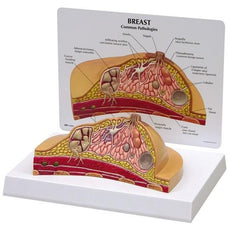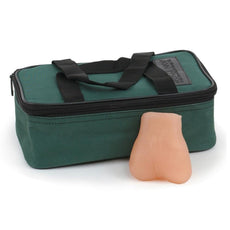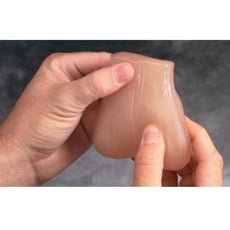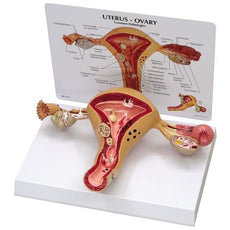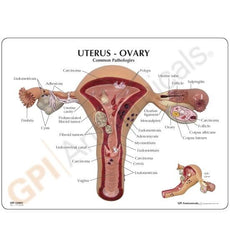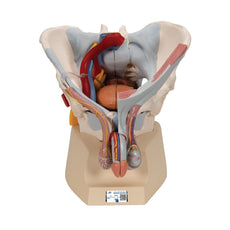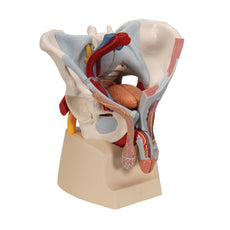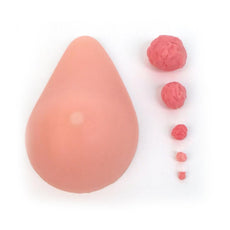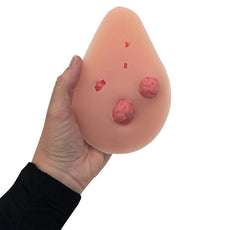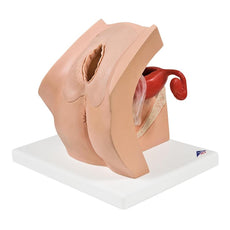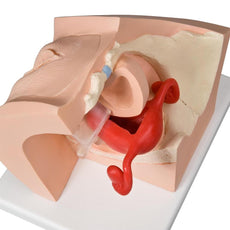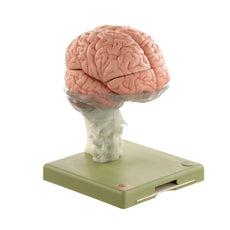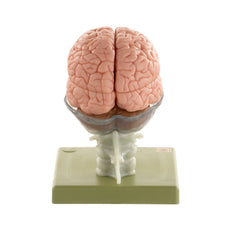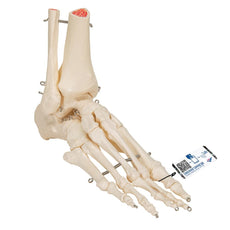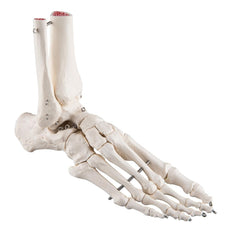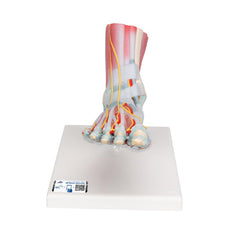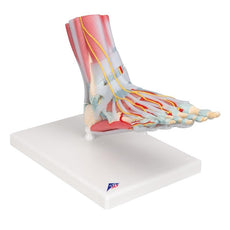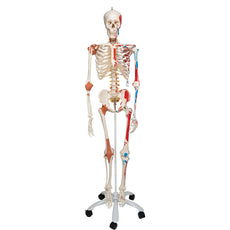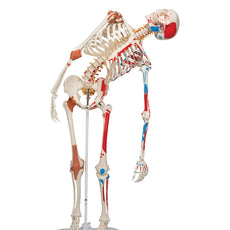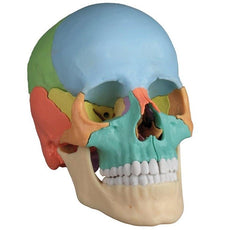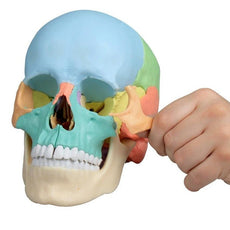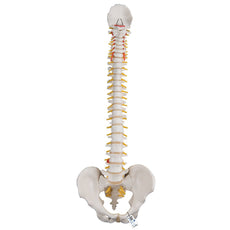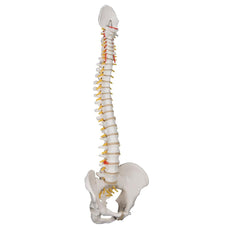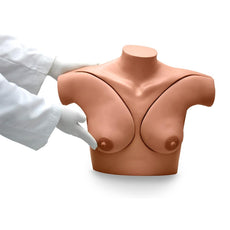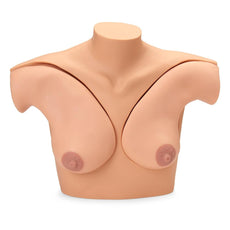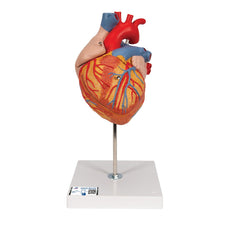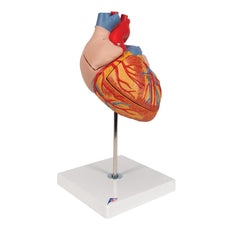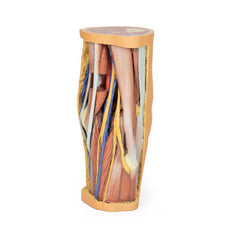Your shopping cart is empty.
3D Printed Popliteal Fossa distal thigh and proximal leg
The skin, superficial fascia, fascia lata and crural fascia has been removed posteriorly to demonstrate the course of the popliteal vessels, tibial nerve and common peroneal nerve. Medially, the semitendinosus and semimembranosus muscles have been sectioned to demonstrate the superior medial genicular artery and the medial head of the gastrocnemius. Distally, the medial gastrocnemius itself has been sectioned to expose the popliteus muscle and the tendon of the plantaris muscle.
The course of the popliteal artery and vein can be traced through the fossa to the passage of the vessels deep to soleus. They are accompanied by the tibial nerve, with the lateral head of the gastrocnemius removed several muscular branches of the tibial nerve are visible in the fossa (as is the medial sural cutaneous nerve and the distal-most part of the lateral sural cutaneous nerve). Running in parallel, the common peroneal descends and passes laterally over the exposed soleus muscle to the neck of the fibula just distal to the attachment of the biceps femoris muscle. Deep to the biceps femoris, the superior lateral genicular branch can be observed passing towards the anterior compartment.
The distal cross-section demonstrates the continuation of popliteal contents and branches. The great saphenous vein, small saphenous vein and sural nerves are visible within the superficial fascia. Between the muscles of the posterior, lateral, and anterior compartments are the neurovascular bundles of the leg (posterior tibial artery, veins and tibial nerve; peroneal artery and veins; anterior tibial artery, veins and deep peroneal nerve).
Download Handling Guidelines for 3D Printed Models
GTSimulators by Global Technologies
Erler Zimmer Authorized Dealer

9.0 lb
🎄 HOLIDAY SAVINGS - Ends Dec 31 🎄
Discount has been automatically applied for this item.
3D Printed Popliteal Fossa distal thigh and proximal leg
Item # MP1820
$1,642.00
$1,825.00
You save $183.00
Need an estimate?
Click Add To Quote

Features & Specifications
-
by
A trusted GT partner -
FREE Shipping
U.S. Contiguous States Only -
3D Printed Model
from a real specimen -
Gov't pricing
Available upon request
Frequently Bought Together
3D Printed Popliteal Fossa Distal Thigh and Proximal Leg
This 3D printed specimen preserves the distal thigh and proximal leg, dissected posteriorly to demonstrate the contents of the popliteal fossa and surrounding region. The proximal cross-section demonstrates the anterior, posterior and medial compartment muscles, with the origin of the popliteal artery and vein just as they have entered the popliteal fossa via the adductor hiatus. The sciatic nerve and great saphenous vein are also visible.The skin, superficial fascia, fascia lata and crural fascia has been removed posteriorly to demonstrate the course of the popliteal vessels, tibial nerve and common peroneal nerve. Medially, the semitendinosus and semimembranosus muscles have been sectioned to demonstrate the superior medial genicular artery and the medial head of the gastrocnemius. Distally, the medial gastrocnemius itself has been sectioned to expose the popliteus muscle and the tendon of the plantaris muscle.
The course of the popliteal artery and vein can be traced through the fossa to the passage of the vessels deep to soleus. They are accompanied by the tibial nerve, with the lateral head of the gastrocnemius removed several muscular branches of the tibial nerve are visible in the fossa (as is the medial sural cutaneous nerve and the distal-most part of the lateral sural cutaneous nerve). Running in parallel, the common peroneal descends and passes laterally over the exposed soleus muscle to the neck of the fibula just distal to the attachment of the biceps femoris muscle. Deep to the biceps femoris, the superior lateral genicular branch can be observed passing towards the anterior compartment.
The distal cross-section demonstrates the continuation of popliteal contents and branches. The great saphenous vein, small saphenous vein and sural nerves are visible within the superficial fascia. Between the muscles of the posterior, lateral, and anterior compartments are the neurovascular bundles of the leg (posterior tibial artery, veins and tibial nerve; peroneal artery and veins; anterior tibial artery, veins and deep peroneal nerve).
Download Handling Guidelines for 3D Printed Models
GTSimulators by Global Technologies
Erler Zimmer Authorized Dealer
These items normal warranty are two years, however the warranty doesn’t cover “wear and tear”. The manufacturer does have 100% quality control on these models.
The models are very detailed and delicate. With normal production machines you cannot realize such details like shown in these models.
The printer used is a color-plastic printer. This is the most suitable printer for these models.
The plastic material is already the best and most suitable material for these prints. (The other option would be a kind of gypsum, but this is way more fragile. You even cannot get them out of the printer without breaking them).The huge advantage of the prints is that they are very realistic as the data is coming from real human specimen. Nothing is shaped or stylized.
The users have to handle these prints with utmost care. They are not made for touching or bending any thin nerves, arteries, vessels etc. The 3D printed models should sit on a table and just rotated at the table.
The models are very detailed and delicate. With normal production machines you cannot realize such details like shown in these models.
The printer used is a color-plastic printer. This is the most suitable printer for these models.
The plastic material is already the best and most suitable material for these prints. (The other option would be a kind of gypsum, but this is way more fragile. You even cannot get them out of the printer without breaking them).The huge advantage of the prints is that they are very realistic as the data is coming from real human specimen. Nothing is shaped or stylized.
The users have to handle these prints with utmost care. They are not made for touching or bending any thin nerves, arteries, vessels etc. The 3D printed models should sit on a table and just rotated at the table.

by — Item # MP1820
3D Printed Popliteal Fossa distal thigh and proximal leg
$1,642.00
$1,825.00
Add to Cart
Add to Quote



